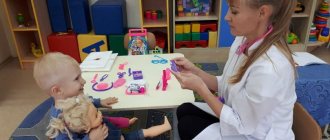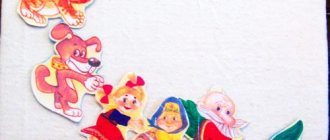Game "Chauffeurs"
Game material. Cars of various brands, a traffic light, a gas station, building materials, steering wheels, a policeman's cap and stick, dolls.
Preparing for the game. Observations of cars on the street, targeted walks to the car park, gas station, garage. Game-activity “Chauffeurs go on a flight.” Observing the games of older children and playing together with them. Learning the outdoor game “Pedestrians and Taxi”. Reading and looking at illustrations on the topic “Chauffeurs”. Reading stories from B. Zhitkov’s book “What did I see?” Construction of a garage for several cars and a truck from building material. Construction of bridges, tunnels, roads, garages from sand.
Game roles. Drivers, mechanic, gas station attendant, dispatcher. Progress of the game. The teacher should begin preparing for the game by organizing special observations of the driver’s activities. They must be directed by the teacher and accompanied by his story and explanation. A very good reason for children to get to know the work of a driver in detail for the first time can be watching how food is delivered to the kindergarten. Having shown and explained how the driver brought the food, what he brought and what will be used from these products later, you need to inspect the car with the children, including the driver’s cabin. It is advisable to organize constant communication with the driver who delivers food to the kindergarten. Children watch him work and help unload the car.
The next step in preparing for the game is watching how food is delivered to neighboring stores. Walking along the street with your children, you can stop at one or another store and watch how they unload the brought products: milk, bread, vegetables, fruits, etc. As a result of such observation, the children should understand that being a driver is not at all doesn’t mean just turning the steering wheel and honking that the driver is driving the car to bring bread, milk, etc.
Also, before the start of the game, the teacher organizes excursions to the garage, to the gas station, to a busy intersection where there is a police traffic controller. It is advisable for the teacher to take another excursion to the garage, but not just any garage, but to the one where the father of one of the pupils in this group works as a driver, where the father will talk about his work. Children’s emotionally charged ideas about their parents’ work and its social benefits are one of the factors that encourage a child to take on the role of a father or mother and to reflect in play their activities at home and at work. The impressions children receive during such walks and excursions should be consolidated in a conversation based on a picture or postcards. During these conversations, the teacher needs to emphasize the social significance of the driver’s activities and emphasize the significance of his activities for others.
Then the teacher can organize a game of toy cars. For example, children are given vegetables, fruits, bread and confectionery products, and furniture made from paper that they sculpted in class. The teacher advises taking food to the kindergarten, goods to the store, transporting furniture from the store to a new home, riding dolls, taking them to the dacha, etc. To enrich the children’s experience and knowledge, it is necessary to show the children on the street different cars (for transporting milk , bread, trucks, cars, fire, ambulance, if possible, show in action machines that water the street, sweep, sprinkle sand), explaining the purpose of each of them. At the same time, the teacher must emphasize that everything that these cars do can be accomplished only thanks to the activities of the driver. The teacher should also consolidate the knowledge acquired by children during walks and excursions by looking at pictures with them depicting a street with different types of cars, and in outdoor games with a plot element. For this game you need to prepare cardboard steering wheels and a stick for the traffic controller. The essence of the game is that each child, driving the steering wheel, moves around the room in the direction that the policeman points to him with his daddy (or hand). The traffic controller can change the direction of movement and stop the vehicle. This simple game, if well organized, brings a lot of joy to children. One of the stages in preparing children for a story game can be watching a film showing a specific case of a driver’s activity and different types of cars. At the same time, over the course of two weeks, it is advisable to read several stories from B. Zhitkov’s book “What did I see?”, conduct several lessons on designing from building materials (“Garage for several cars”, “Truck”), followed by playing with buildings. It’s good to learn with your children the outdoor game “Colored Cars” and the musical and didactic game “Pedestrians and Taxi” (music by M. Zavalishina). On the site, children, together with their teacher, can decorate a large truck with multi-colored flags, carry dolls on it, and build bridges, tunnels, roads, and garages in the sand during walks. The game can be started in different ways. The first option could be as follows. The teacher invites the children to move to the dacha. First, the teacher warns the children about the upcoming move and that they need to pack their things, load them into the car and sit down themselves. After this, the teacher appoints a driver. On the way, you should definitely tell your children about what the car is passing by. As a result of this move, the doll corner is moved to another part of the room. Having sorted things out at the dacha and settled in a new place, the teacher will ask the driver to bring food, then take the children to the forest to pick mushrooms and berries, or to the river to swim and sunbathe, etc. After a few days, the game can be repeated in another version - move from the dacha to city, take the children to see how the streets were decorated for the holiday, take everyone to the doctor to weigh them after the dacha, etc. Further development of the game should go along the lines of connecting it to other game themes, such as “Shop”, “Theater” , “Kindergarten”, etc. Another option for the development of this game could be the following. The teacher takes on the role of a “driver”, inspects the car, washes it, and, with the help of the children, fills the tank with gasoline. Then the “dispatcher” writes out a waybill, which indicates where to go and what to transport. The “Chauffeur” leaves for the construction of a residential building. Further, the plot develops in this way: the driver helped build the house. Then the teacher introduces several roles of “drivers” and “builders” into the game. The children, together with the teacher, are building a new house for Yasi and her mom and dad. After this, the teacher encourages the children to play on their own and reminds the children that they themselves can play as they wish. During the subsequent game of “drivers”, the teacher introduces new toys - cars of various brands, which he makes together with the children, a traffic light, a gas station, etc. Also, children, together with the teacher, can make new missing toys (car repair tools, a cap and a stick policeman-regulator), improve ready-made toys (using plasticine, attach a trunk to a passenger car or an arc to a bus, turning it into a real trolleybus). All this helps to maintain interest in the device, purpose and methods of using the toy in the game. At this age, children's games of "drivers" are closely intertwined with games of "construction", since drivers help build houses, factories, and dams.
You can find out more on the website: Activities with children.




